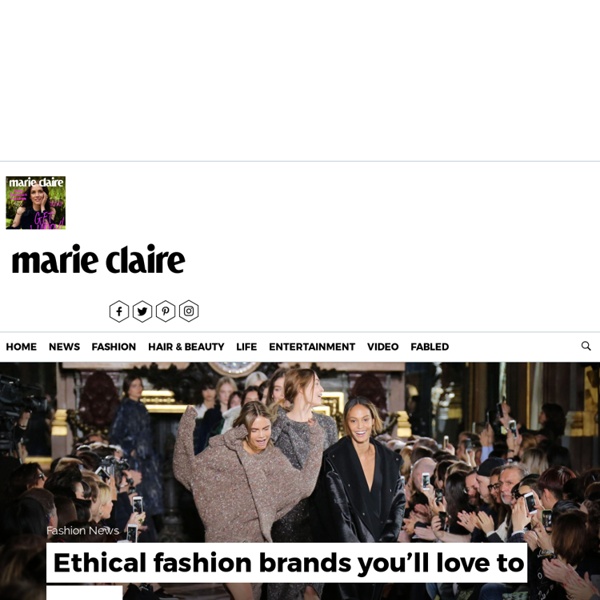Emma Watson's Guide to Ethical Fashion
Ethical fashion is an important issue to Emma; she signed up to the Green Carpet Challenge in 2015, agreeing that every single piece she wears on the red carpet would be sustainable. Her Calvin Klein Met Gala 2016 gown, for example, was made out of recycled plastic bottles and her Emilia Wickstead Beauty and the Beast gown is made from end-of-line fabric, and that's far chicer than it sounds. She isn't just showing how fashion houses can use innovative technology to create magnificent, sustainable red carpet and day-to-day pieces, however. She also sees it as her fashion mission to highlight emerging cutting-edge brands that are produced responsibly, and her stylist, Rebecca Corbin Murray, is constantly scouting for new labels by crowdsourcing on Instagram. Last year, Emma even collaborated with ethical label Zady on a capsule collection, once again proving you can dress stylishly while still sticking to your principles.
Stellantis soutient ses ambitions en matière d’économie circulaire avec une Business Unit dédiée conçue pour initier une nouvelle ère de fabrication durable et de consommation responsable | Stellantis
L’économie circulaire joue un rôle majeur pour permettre à Stellantis d’atteindre une empreinte carbone neutre à l’horizon 2038Mise en place d’un modèle commercial Cradle to Cradle (du berceau au berceau) qui permettra de générer plus de 2 milliards d’euros de chiffre d’affaires d’ici 2030, conformément au Plan Stratégique Dare Forward 2030Les Hubs de chaque grande région seront soutenus par des boucles locales permettant de gagner en efficacité et de préserver les ressources limitées de notre planèteLe nouveau label SUSTAINera permet une transparence sur les économies de matériaux et de CO2 ; il représente la promesse de solutions de produits et de services durables et abordables Vidéo : L’économie circulaire chez Stellantis - Vue d’ensemble par Alison Jones Économie circulaire, la stratégie des 4R : Stellantis a développé une activité complète à 360° basée sur la stratégie des 4R : reman repair, reuse et recycle. Des Hubs soutenus par des boucles locales Présentation de SUSTAINera
Eco-challenges : encourager les salariés à l’écologie en entreprise
Pour les chefs d’entreprise, il y a un réel intérêt à solliciter l’engagement de leurs salariés à travers des challenges écologiques. En plus de l’impact positif sur la planète, ces défis peuvent aussi être l’occasion de faire réaliser des économies à l’entreprise à moyen et long terme, mais aussi d’échanger et de tisser des liens. On vous donne quelques idées dans cet article. Valoriser l’engagement des salariés pour la planète Une des raisons souvent invoquées par les salariés mécontents au travail, c’est le manque de reconnaissance et le « manque de sens » dans leurs tâches. Des exemples de challenges écologiques en entreprise Il n’y a pas de limites en ce qui concerne la façon de susciter l’engagement écologique des salariés d’une entreprise. On peut aussi proposer aux salariés un challenge « réduction des déchets » par étage ou par bureau (pour éviter le « shaming » individuel !) Des défis écolos qui peuvent déboucher sur des économies
20 idées simples pour rendre votre entreprise plus durable
Et si vous essayiez de rendre votre entreprise plus durable et responsable ? Voici 20 gestes pour y parvenir facilement. Être responsable, être écolo, être plus attentif aux autres, cela doit aussi se faire dans l’entreprise. En effet, nous passons une bonne partie de notre vie dans nos entreprises, et une grande part de nos impacts sur l’environnement ont lieu dans l’entreprise. De ce fait, les choix que nous faisons dans notre vie quotidienne au travail, dans l’entreprise peuvent aussi participer à la transition vers un monde plus juste et plus responsable. Le problème, c’est qu’il n’est pas forcément évident de savoir comment faire pour être un employé plus responsable dans une entreprise plus responsable. Les gestes pour réduire ses déchets 1 – Se former aux règles du recyclage En entreprise, le recyclage ce n’est pas trop ça. 2 – Eviter les gobelets en plastique et autres couverts jetables 3 – Soyez rationnels au déjeuner ! 4 – Mesurer votre impact déchet Du sport en entreprise ?
Démarche RSE & éthique | Châteauform'
L’aventure Châteauform’ est née en 1996 autour d’une idée : concevoir les séminaires autrement et les appréhender comme des lieux d'échanges professionnels dans un cadre propice à l’innovation et à la construction de relations humaine solides, tout en se sentant comme à la maison, en famille. La loi du 9 décembre 2016 dite « Sapin II » relative à la transparence, à la prévention de la corruption et à la modernisation de la vie économique est une formidable opportunité pour Châteauform’ et ses talents. Celle de rappeler, à travers cette Charte Ethique, notre ambition d’une totale intégrité dans la conduite de nos affaires, celle de mettre en avant deux de nos valeurs fondatrices que sont la loyauté et l’honnêteté. Gardons toujours à l’esprit que les principes éthiques énoncés dans ce document ne sont pas facultatifs et que la réputation de Châteauform’ et la confiance de toutes nos parties prenantes dépendent de chacun de nous. Daniel Abittan
Loire-Atlantique déjà très fortement engagé vers un numérique responsable
Dès son arrivée il y a trois ans, Safia D’Ziri, directrice solutions numériques au Département de Loire-Atlantique, et ses équipes, ont mené un vaste plan d’actions pour moderniser l’T du département tout en s’engageant vers un numérique responsable. Gage de cet engagement, le département a adhéré à la charte Numérique Responsable portée par l’INR (Institut du Numérique Responsable). Ce plan se déroule suivant plusieurs volets. Déjà, la réduction de la consommation énergétique des datacenters qui s’est traduite par la migration des anciennes infrastructures vers des systèmes hyperconvergés ; cette étape aurait permis de gagner 50 % sur la consommation d’énergie selon Safia D’Ziri. Communication et sensibilisation auprès des agents Augmenter la durabilité des équipements IT Le département s’est aussi attaqué à sa politique d’équipements IT.



